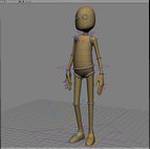in the SDK there are two commands for roll divsions, MakeBicepRoll, and MakeForearmRoll.
I'm wanting to add some roll division controls to an ICE IK FK solver I put together, and was hoping somebody had some insight behind these commands.
From the Docs:
I'm trying to make some sense out of this, I feel really stupid though. What is spin?The start and end rotations are determined differently for a forearm roll and bicep roll (MakeBicepRoll). In forearm roll, the starting rotation is the forearm's rotation minus any spin, calculated using the bicep's rotation. The end rotation is the next bone's rotation (wrist) with spin. Roll division rotations are then interpolated between the start and end. In the case of bicep roll the bicep bone is used for both start and end rotations. The start rotation is the bone's rotation minus spin, the end rotation is its rotation with spin.
I'd like to come up with the math behind this so I can set the roll divisions transforms in ice. I think I'm overcomplicating things though, can someone please help me make some sense of this.
the more I read that quote from the docs, the more i think it's worded more complicated than it really is. lol.



































































